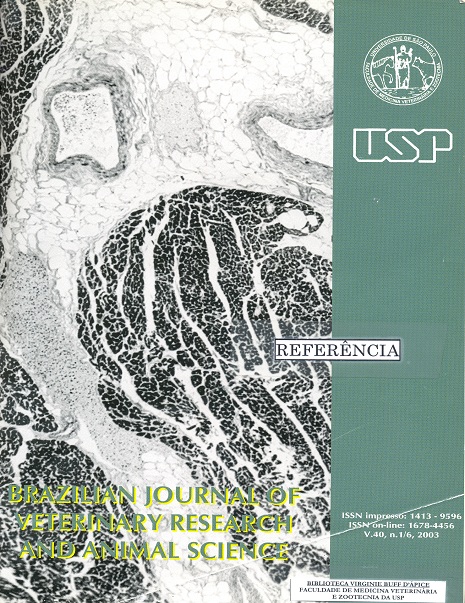Vesicular Stomatitis: Serological Survey in beef cattle from region of Araçatuba, São Paulo State, Brazil in 2000
DOI:
https://doi.org/10.1590/S1413-95962003000100003Keywords:
Vesicular Stomatitis, Antibodies, Beef cattleAbstract
In 2000 a total of 1099 serum samples were obtained of adult beef cattle, from 6 herds located at Auriflama, Gastão Vidigal,, Magda, Santo Antônio do Aracanguá, Sebastianópolis do Sul e Turiúba, counties from the region of Araçatuba. Sera were tested for neutralizing antibodies to vesicular stomatitis virus by microtiter neutralization assay, using the virus strain Indiana 1 Costa Rica/72 with 10(6,0) DICT50/50mL. The indicator cells were African green monkey kidney (VERO-CCL 81), purchased from American Type Cell Colection (ATCC). The neutralization titers of each serum were the reciprocal of the highest dilution expressed at log10 that protected 100.00% of the cell monolayer. Sera with values above 1,6 log10 (1/40) were considered positive for Vesicular Stomatitis virus. Twenty-eight (2.50%) out of 1.099 samples were positive for Vesicular Stomatitis virus Indiana 1, with antibodies titers ranging from 1.9 to 2.8. Except in Turiuba, in the others 5 herds there were positive animals. The presente survey showed the presence the Vesicular Stomatitis virus in the herds stimulating the humoral response. More studies are necessary to verify the site of persistence of the virus.Downloads
Download data is not yet available.
Downloads
Published
2003-01-01
Issue
Section
UNDEFINIED
License
The journal content is authorized under the Creative Commons BY-NC-SA license (summary of the license: https://
How to Cite
1.
De Stefano E, Araújo WP de, Passos E de C, Pituco EM. Vesicular Stomatitis: Serological Survey in beef cattle from region of Araçatuba, São Paulo State, Brazil in 2000. Braz. J. Vet. Res. Anim. Sci. [Internet]. 2003 Jan. 1 [cited 2024 Apr. 19];40(1):29-35. Available from: https://www.revistas.usp.br/bjvras/article/view/11388





